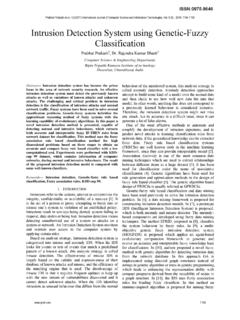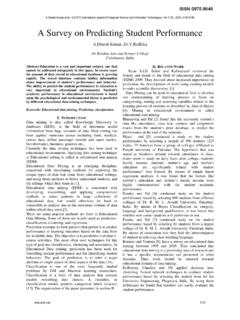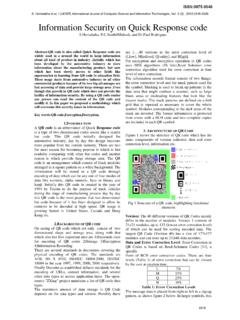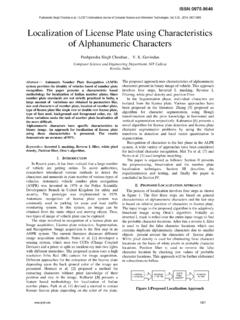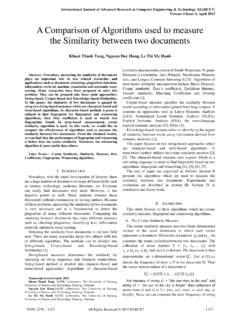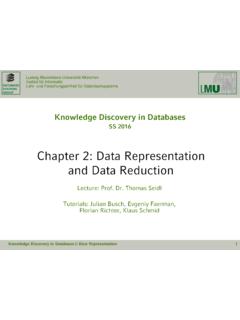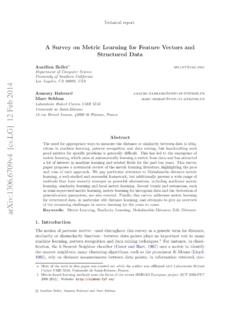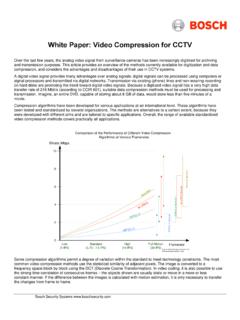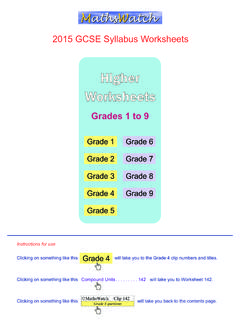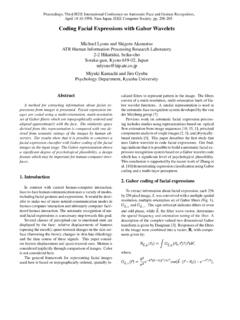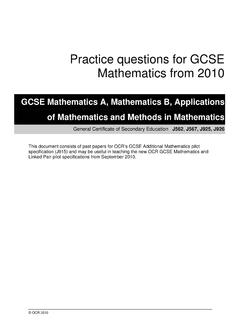Transcription of An Implementation of the User-based Collaborative ...
1 An Implementation of the User-based Collaborative filtering algorithm Maddali Surendra Prasad Babu Boddu Raja Sarath Kumar Professor, Dept. of CS&SE, Professor, Dept. of CSE, AUCE, Andhra University Lenora College of Engineering Andhra Pradesh, Visakhapatnam Rampachodavaram-533288, Abstract - Collaborative filtering algorithms (CFAs) are most popular recommender systems for collaborating one another to filter the documents they read from the last decade. C F A s have several features that make them different from other algorithms. The C l a s s i f i c a t i o n accuracy is one among them. A User-based Collaborative filtering algorithm is one of the filtering algorithms, known for their simplicity and efficiency.
2 In the present paper a steady is conducted for its Implementation and its efficiency in terms of prediction complexity Key words Collaborative filtering algorithm , Mean Absolute Error, Prediction Complexity 1. INTRODUCTION The growth and availability of data on the internet has caused information overload and hence searching for a query is not an easy task for an individual in the sources of information available. The amount of information found in the Internet, is growing day by day. Personalized retrieval systems are becoming more interesting, especially when not limited to just searching for information but that also to recommend the items that would be more appropriate for the user 's needs or preferences There are mainly two types of recommender systems, as a function of the algorithm used: Content- based filtering (CBF) and Collaborative filtering (CF).
3 CF is one of the most commonly used methods in personalized recommendation systems. Collaborative filtering algorithm recommend items based upon opinions of people with similar tastes. Collaborative filtering can also recommend items that are not similar and like-minded users have rated the items. Collaborative filtering faced some problems by traditional information filtering duly eliminating the need for computers to understand the content of the items. Recommender systems need to store certain information about the user preferences, known as the user profile to achieve this personalization. CF is also further classified as three main filtering techniques [1]: They are (i) Memory- based Collaborative filtering (ii) Model- based Collaborative filtering and (iii) Hybrid Collaborative filtering .
4 In recent years research in recommender system was carried out by R. Bell [2], Manos Papagelis [3], R. Salakhutdinov [4][6], Bhaskar Mehta[5][7], J. Sandvig[8]. The system will inform the user of what items are well recommended by other users with similar likes or interests. An analysis of the content by the system is not necessary and the quality or subjective evaluation of the items will be considered. However, these algorithms present problems in their computational performance and efficiency. These systems have different techniques, though some of them may be general enough to be applied to various techniques. CF techniques use a database of preferences for items by users to predict additional topics. Other technologies have also been applied to recommendation systems including Bayesian networks, Pearson Correlation, Cosine Correlation, Clustering and Horting.
5 2. SOME IMPORTANT CFAs WITH PREDICTION COMPLEXITY Memory based CFA user rating data is used to compute similarity between users or items. This is used for making recommendations [1] and is used in many commercial systems. It is easy to implement and is effective. Some important algorithms are: User-based Collaborative filtering , Item- based Collaborative filtering and Similarity fusion Collaborative filtering . Memory- based CFAs use the entire or a sample of the user -item database to generate a prediction. By identifying the neighbors of a new user , a prediction of preferences on new items for him or her can be produced. When the task is to generate a top-N recommendation, we need to find the most similar users or items after computing the similarities, and then aggregate the neighbors to get the top-N most frequent items as the recommendation.
6 Model based CFA These are used to make predictions for real data. To find patterns based on training data models are developed using data mining and machine learning algorithms [1]. Some important algorithms are: Bayesian belief nets Collaborative filtering , Regression based Collaborative filtering , Slope one Collaborative filtering , Latent Semantic Indexing Collaborative filtering and Cluster based smoothing Collaborative filtering The design and development of models can allow the system to learn to recognize complex patterns. Then make intelligent predictions for the Collaborative filtering tasks for real-world data. The above mentioned, Model- based CF algorithms have been investigated to solve the drawbacks of memory- based CF algorithms. Hybrid CFA A number of applications combine the memory- based and the model- based CF algorithms.
7 These overcome the limitations of native CF approaches [13]. It improves the prediction performance and overcomes the CF problems such as sparsity and loss of information. A hybrid CF also known as Content Boosted Collaborative filtering , a p p r o a c h was proposed to exploit b u l k information Maddali Surendra Prasad Babu et al, / (IJCSIT) International Journal of Computer Science and Information Technologies, Vol. 2 (3) , 2011, 1283-12861283 designed for exact product classification to address the data sparsity problem of CF recommendations. Some important algorithm is: Personality diagnosis Collaborative filtering Hybrid CFAs combine CF with other recommendation techniques to make predictions. Content- based CF makes recommendations by analyzing the content of textual information.
8 Many elements contribute to the importance of the textual content. A content- based recommender then uses classification algorithms to make recommendations. Content- based techniques have the cold-start problem, in which they must have enough information to build a reliable classifier. They are limited by the features explicitly associated with the objects they recommend, while Collaborative filtering can make recommendations without any descriptive data. Content- based techniques only recommend items that score highly against a user s profile. Other recommender systems includes demographic information gender, postcode, occupation etc,. Utility- based recommender systems and knowledge- based recommender systems are the systems which require knowledge about how a particular object satisfies the user needs.
9 3. user based Collaborative filtering algorithm User-based CF algorithm produces recommendation list for object user according to the view of other users. The assumptions are if the ratings of some items rated by some users are similar, the rating of other items rated by these users will also be similar [3]. CF recommendation system uses statistical techniques to search the nearest neighbors of the object user and then basing on the item rating rated by the nearest neighbors to predict the item rating rated by the object user , and then produce corresponding recommendation list. Collaborative filtering component that uses a neighborhood- based algorithm is as follows. In neighborhood based algorithms, a subset of users are chosen based on their similarity to the active user , and a weighted combination of their ratings is used to produce predictions for the active user .
10 The algorithm can be summarized in the following steps: Step: 1. all users are weighted with respect to similarity with the active user . Similarity between users is measured as the Pearson correlation between their ratings vectors. Step: 2. Select n active users that have the highest similarity. Step: 3. Compute a prediction, Pa,u from a weighted combination. Similarity between two users is computed using the Pearson correlation coefficient rnirniuiuaiarniuiuaiauarrrrrrrrP113,3,1, ,,)()()()( (1) Where r a,i is the rating given to item i by user a; and ra is the mean rating given by user a. In step 3, predictions are computed as the weighted average of deviations from the neighbor's mean: nuuanuuauiuaiaPPrrrP1,1,,,)( (2) Where Pa,i is the prediction for the active user a for item i.


